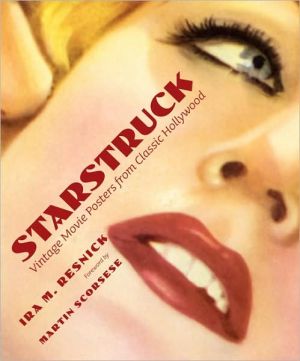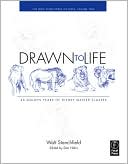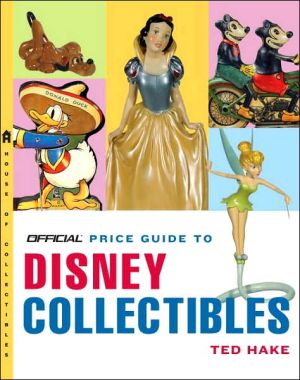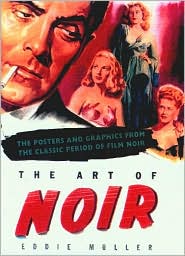Starstruck: Vintage Movie Posters from Classic Hollywood
For four decades film historian Ira M. Resnick has been amassing a superb collection of 2,000 vintage movie posters and 1,500 stills, which has never before been published. Starstruck: Vintage Movie Posters from Classic Hollywood features the best of Resnick's collection, with vivid reproductions of 250 posters and forty stills from a golden age of Hollywood, from 1912 to 1962.\ \ In a moving introduction, Resnick relates how his love of vintage movie art translated into a career as a...
Search in google:
For four decades film historian Ira M. Resnick has been amassing a superb collection of 2,000 vintage movie posters and 1,500 stills, which has never before been published. Starstruck: Vintage Movie Posters from Classic Hollywood features the best of Resnick’s collection, with vivid reproductions of 250 posters and forty stills from the golden age of Hollywood, 1912 to 1962.In a moving introduction, Resnick relates how his love of vintage movie art translated into a career as a collector and the founder of the Motion Picture Arts Gallery, the first gallery devoted exclusively to the art of the movies. Resnick’s firsthand account offers entertaining anecdotes about how he managed to acquire such stellar film artwork, as well as historical information about the stars and films shown on the pieces he collected.Guiding the reader through the best posters and stills of his collection, Resnick provides a tour of cinematic history, starting in the silent film era and continuing up to Breakfast at Tiffany’s (1961). By showcasing several posters for each performer—such as Lillian Gish, the Marx Brothers, Marilyn Monroe, John Barrymore, and Audrey Hepburn—Resnick offers a unique method of charting the evolution of each movie star’s career.Organizing his account both chronologically and thematically, in later chapters Resnick discusses some of Hollywood’s legendary directors and films, and critiques fantastic graphic art from little-known films. Bonus material includes a list of Resnick’s fifty favorite one-sheets, helpful tips for the collector, and a glossary of terms and poster sizes.A must-have book for every collector and film buff, Starstruck offers a beautifully illustrated, personal tour of a bygone age of the motion picture advertising industry.
Introduction\ Introduction\ I bought my first film posters forty years ago, and I still have all three. I found them at Cinemabilia, a now-legendary movie bookstore on Cornelia Street in Greenwich Village. I paid $50—a heavy price at the time—for a title lobby card from Stage Door (figure 000), and $35 each for one-sheets promoting Love Before Breakfast (figure 000) and The Awful Truth (figure 000). This was the modest beginning of a collection of posters and stills, spanning the years 1912 to 1962, which now numbers in the thousands. Initially I was attracted to them because they appealed to my visual sense and reinforced the pleasure I had recently discovered in the world of classic movies, and then, as the collection grew, because they gave me access to a vivid slice of American history. In time I came to feel that I had a responsibility to preserve these artifacts, once taken for granted and considered ephemeral, now increasingly rare and precious as representatives of a lost era. When all is said and done, though, I fell in love with film posters because they let me cut myself a slice of movie magic, because they provided me with a special and almost visceral connection to the movies I loved, and to the actors and actresses who brought them to life.\ Bottom line, I was starstruck.\ Back in the golden age of Hollywood, long before television and the Internet, posters were the principal means used by the movie studios to alert the public to current and upcoming releases. The artwork for them was produced by studio publicity departments, and poster exchanges around the country provided theater owners with a constant stream of material designed to fit display cases in several different standard sizes, ranging from the half-sheets and one-sheets found inside lobbies, to the larger three-sheets and six-sheets typically found at theater entrances, right up to gigantic twenty-four-sheet billboard-sized posters. There were also window cards, distributed to local merchants for exhibition in their storefronts, and—a key category for collectors—lobby cards, issued in sets of eight consisting of a title card—generally similar to the poster art and showing the credits—along with seven others illustrating key scenes from the movie. Theater owners would select cards and posters from a press book and rent them for a nominal fee. In theory they were supposed to return them to the exchange when the promotion was over, but this didn’t always happen. Some were simply thrown out, and many of those that were dutifully returned were pulped, often as the result of World War II paper drives. Luckily a few were taken home and saved by movie-loving projectionists or theater ushers—fans of all stripes—while others sat for years in storage rooms, attracting no attention until an old theater was threatened by the bulldozers. The posters that survive today are valuable because they escaped the normal process of attrition. All of them are rare. A few are rarer than paintings by Vermeer.\ To build my collection, I haunted flea markets and stores that cater to the desires and needs of the movie-smitten; I scoured country salesrooms and bid at auctions at Sotheby’s and Christie’s; I jumped on airplanes to follow promising leads, and bargained with collectors who would tease year after year with tantalizing glimpses of some gem from Paramount or Columbia. I developed a network, and finally opened my own gallery, which enabled me to see a lot of material I might not otherwise have had access to, and to expand my collection, the cream of which is represented on these pages.\ I do not wish to pretend that my collection should be taken as historically comprehensive. Only a museum could aspire to completeness. I think, though, I can claim a broad knowledge of the history of cinema—especially of the varied and wonderful movies that came out of Hollywood between the heyday of silent films and the demise of the studio system in the 1950s—and I believe that my collection encapsulates significant parts of that history; but I’m happy to admit that ultimately it’s a reflection of my own taste and preferences.\ Collecting these beautiful artifacts, over the past forty years, has allowed me to preserve the sense of what particular movies meant to me. Surrounding myself with images that evoke the mood of a favorite comedy or musical has meant that the party didn’t have to end when the film was over. They conjure up a world peopled with actors and actresses who for me possess the same kind of magic I associate with the fairy-tale characters of my earliest memories. I’ve been bewitched by these fabulous performers, and I hope that as you turn these pages, you too will experience some of that enchantment.\
Foreword Introduction1 The Education of a Collector2 Falling in Love Again (and Again): The Development of a Collection3 The Silents, 1912–19294 The Golden Age of the Talkies: The Women, 1927–19415 The Golden Age of the Talkies: The Men, 1927–1941 6 From Citizen Kane to Breakfast at Tiffany’s, 1941–19627 Great Directors8 Classic Films9 Little-Known Movies with Great GraphicsMy Fifty Favorite One-sheetsA Guide for the Movie Poster CollectorAcknowledgments BibliographyIndex







